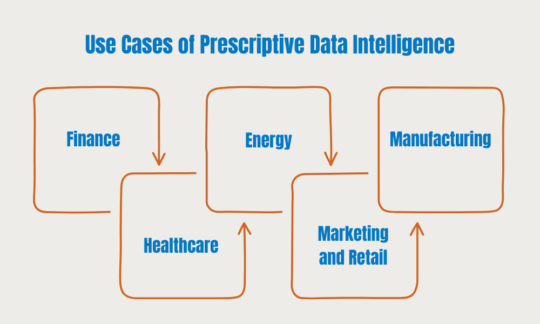Data-driven approaches are always fruitful for enterprises in the highly competitive market. Data analytics, in this regard, has remarkably assisted companies of all sizes. From identifying ongoing trends to determining upcoming forecasts, analyzing data unlocks the doors to business success in many ways.
Prescriptive analytics is one of the four types of data analytics that not only tracks the problems in a business by assessing relevant databases but also offers operational solutions to the same. The method utilizes advanced data evaluation tactics to provide optimal resolutions to identified challenges.
This blog shall revolve around prescriptive data analytics, its benefits in business, and use cases in diverse sectors. Let’s dig in...
What is Prescriptive Analytics?
Prescriptive analytics, also known as prescriptive intelligence, is a form of data analytics that assesses datasets to identify patterns, make predictions, and offer operational solutions to possible difficulties. Marketers and business leaders consider this form of data analytics valuable for data-centric decision-making. Let us understand the types of data or business analytics:
There are broadly four methods of analyzing data:
-
- Descriptive analytics: It focuses on analyzing “what happened?”
- Diagnostic analytics: It tracks the causes of an occurrence through “Why did it happen?”
- Predictive analytics: It stresses making predictions through determining “What might happen next?”
- Prescriptive analytics: It guides on what to do next with “What should we do next?”
Prescriptive data analytics highly relies on machine learning algorithms to process larger datasets quickly and effectively. These algorithms not only identify patterns in complex data but also offer recommendations to tackle potential threats.
The recommendations are data-driven; hence, businesses can easily integrate them. For this purpose, companies are strikingly adopting this strategy. It also automates certain business activities, with which organizations can optimize their operations.
Benefits of Prescriptive Analytics in Business:
Real-time analytics: Businesses intend to get real-time analytics into their market and audience to streamline their operations. Prescriptive data analytics offers real-time insights by gathering and assessing data from various sources.
Comprehend the overall scenario better: Real-time insights assist business leaders in understanding the different dynamics of their target market. Prescriptive data analytics simplifies complex data into understandable insights that assists in the knowledge gaining process.
Optimal decision-making: Prescriptive intelligence provides operational recommendations on what to do next. The method supports businesses in data-driven decision-making. Alongside that, the recommended solutions also play a pivotal role in threat or risk management.
Prescriptive Data intelligence Use Cases:
Prescriptive analytics is advantageous for almost all sectors, including finance, healthcare, retail, energy, manufacturing, marketing, and others. Let us discuss a few use cases and examples of the same.
Finance:
The finance sector has many risks that can create difficulties in regular operations. With prescriptive intelligence, organizations can easily identify and address any evolving risks.
Healthcare:
Different patients have different requirements alongside dissimilar health conditions. Prescriptive data intelligence can help analyze each patient's situation and needs. By understanding these elements, healthcare companies will be able to offer better services to their patients.
Energy:
Prescriptive data analytics in the energy sector assists in understanding demand and the need of a particular product or service. Moreover, it can also contribute to service or product quality enhancement. By assessing these elements, companies can strategize their next step.
Marketing and Retail:
In marketing and retail sectors, prescriptive data intelligence can easily automate price-setting and customer support activities. It further enhances the possibilities of evaluating customer behavior for better marketing efforts.
Manufacturing:
With effective predictions and problem-solving tactics, prescriptive intelligence can identify shortcomings in products and analyze customers' expectations. Enterprises can then plan changes and increase production accordingly.
Wrapping Up!
Prescriptive analytics collects structured or unstructured data from various sources. Machine learning algorithms assist in assessing the datasets, finding patterns, and deploying them to articulate optimal recommendations. Thus, the whole process is data-driven, which is crucial to making firm decisions and running successful businesses. Follow our blog updates and explore the ongoing tech practices.
Recommended For You:
The Best 5 Data Analytics Tools for 2024
Success Stories Businesses Thriving with Data Mining in Business Intelligence





